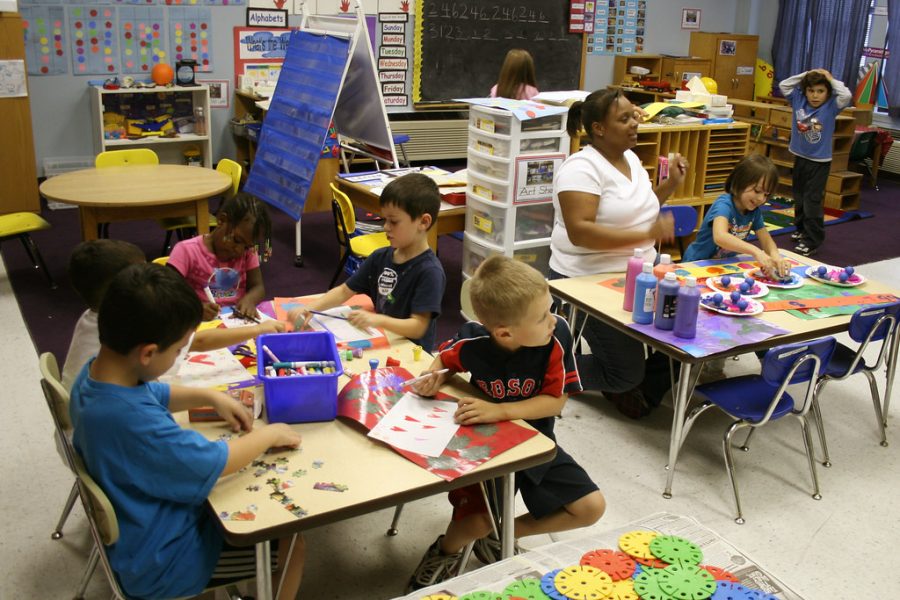Scott: Shielding White Children From The Reality of Racism is a Failure
(Courtesy Flickr)
June 12, 2020
When I was in second grade, my teacher performed a rendition of Jane Elliott’s controversial “Blue Eyes/Brown Eyes” exercise. The “Blue Eyes/Brown Eyes” exercise takes a group of people, separates them by eye color, and proceeds to discriminate against one group while favoring the other. Whether performed with children in elementary school classrooms or the adult audience of The Oprah Winfrey Show, it is astounding how quickly participants conform to the hierarchy presented by the experiment.
My teacher separated us by the color of our pants. She glowed over the students wearing dark pants. They were the picture of intelligence and responsibility, and so they were offered free time and pieces of candy for being such ideal students. The group with light pants (of which I was apart) stared at the floor as we were told that we were naturally rude, less intelligent and unable to change. We were reprimanded, worked as our peers played and were certainly never offered any candy.
After allowing those of us with light pants to spend a good while languishing in our newfound inferiority, my teacher gathered us together around her reading chair in the back of the class. She explained that our “light pants/dark pants” exercise was an allegory for racism, and that the bad feelings we felt were only temporary, whereas the discrimination and hatred faced by people of color was a lifelong struggle. Everyone looked drained, and my teacher attempted to ease our seven and eight-year-old minds with another round of candy, this time for the entire class.
I remember declining the caramel apple pop she offered from the bag. A lead weight had landed in the pit of my stomach when she told us that we were naturally inferior and felt insulted that she thought candy could rectify it. At that age, I was consumed with the desire to be smart and utterly dependent on affirmation from adults. To have lost my teacher’s favor — even momentarily — shattered me, and I was unable to distance myself from that feeling for the rest of the day.
That rest of the day part is important, because though I had just been given a harsh lesson on racial discrimination, I was still a white child who was unlikely to encounter such a visceral experience again. Frankly, I still haven’t, which is why I am so grateful for my teacher for being willing to rewire my perception of racism. While neither the exercise, its creator Jane Elliott nor myself are perfect, I believe that my ability to offer empathy and recognize my own privilege would have been underdeveloped if I had never had that lesson. The experience still sears, even sixteen years later.
People have always bristled at Elliott’s method, but that cold, hard dose of reality is critical to its success. There is perhaps a question about the ethics of putting students in such a distressing environment, but real-life racism is offensive, illogical and unrelenting, so what real use is a lesson that sands off the edges? Prejudice is so resilient and so destructive that it is better for children to be warned of it early, even if it involves one very difficult afternoon in class.
Elliott and my teacher understood that racism is a tradition taught early, that by as early as three years of age, most children “have learned to categorize people into ‘good or bad’ based on superficial traits, such as race or gender” and “can show signs of being influenced by what they see and hear around them.” They saw that their students were disproportionately affected by various societal rules — some students, like myself, were generally oblivious to the cudgel of racism while others were already learning to conform to avoid being whacked.
To love a child is to prepare them, even if it involves breaking their heart. Parents of children of color are not given an option to protect their child’s innocence — they must have “the talk” early lest their child learn it the hard way from schoolyard bullying or a frightening encounter with authority. Racism steals the childhood of black girls who are perceived as less innocent than white girls and black boys who grow up with the devastating stories of George Stinney Jr., Emmett Till, Trayvon Martin and Tamir Rice.
Black children cannot opt-out of the talk, while it is not guaranteed that their white peers receive even an elementary level discussion about racism. By selectively shielding children from reality, we prevent white children from developing the empathy necessary to fight racist beliefs while subjecting children of color to carry the burden unacknowledged.
i think often of this 2015 painting: “The Talk” by Michael D'Antuono (2015) pic.twitter.com/Tn25tf9oWX
— tabia yapp (@tabiayapp) May 28, 2020
I am not arguing that all children must experience a reality check as personal as Elliott’s exercise (though I don’t believe it would harm them) but they should engage in regular, honest discussions about prejudice and hatred. They are perfectly positioned to develop a resistance to bigotry, provided the adults in their life are willing to give them the opportunity. Sensitive to injustice and capable of managing discomfort, children can often handle far more than adults expect. To underestimate them and leave them out of the fight against racism is a colossal failure.
White people should not accept the comfort of ignorance. We should be morally and virulently opposed to contributing to the suffering of others. And that is why we must do anti-racist work quietly, consistently, by extending it to the most precious part of our lives — our children. Anti-racism must be among the earliest, most-emphasized lessons that we offer them. To be committed to the eradication of racism is to instill it as the core of future generations. According to Elliott, racism as we practice it is about 500 years old. “We could destroy it, if we chose to. But that would take education.”








